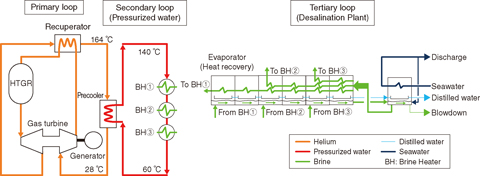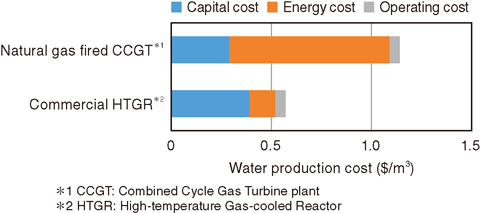
Fig.6-8 Flow diagram of the HTGR desalination system

Fig.6-9 Cost evaluation of water production with a conventional gas-fired desalination plant and a commercial HTGR plant
High-temperature gas-cooled reactors (HTGRs) produce not only electricity but also intense heat usable for a variety of applications. We have proposed a commercial HTGR called GTHTR300. With a 600 MWt thermal power, the GTHTR300 generates about 300 MWe of electricity using a helium gas turbine while rejecting about 300 MWt in waste heat from the precooler of the gas turbine system. In this study, a new proposal for an HTGR desalination system and its water-production cost were investigated to evaluate the economics of heat utilization from an HTGR.
Multistage flash (MSF) was selected as the desalination method. Since it is applicable to the temperature range (approximately 160 ℃) of HTGR waste heat and offers the greatest maturity and reliability in the world. In MSF, a seawater stream is sequentially heated in the evaporators and the brine heaters and then returned to the flash chamber in the evaporators. The heated brine undergoes flash evaporation by regulating the pressure in the evaporator chambers, and the vaporized water is condensed on the heat-transfer tubes and collected as product water.
The waste heat of an HTGR is supplied through the secondary pressurized water loop and brine heaters. However, a conventional single brine-heater MSF can achieve a quite low performance ratio because of the narrow temperature range of sensible waste heat from the gas turbine system. We therefore proposed the concept of a multiple-brine heater MSF system (Fig.6-8). It was found that the performance ratio of the new MSF increases with the number of brine heaters used. On the other hand, the increase in the number of brine heaters leads to increase in the construction cost. A trade-off study between the performance ratio and the construction cost indicated that the optimum number of brine heaters was three. Based on this finding, the components and plant layout were designed, and the water production cost was estimated. The comparison of the water-production cost between the conventional MSF system with a typical natural gas-fired combined cycle gas turbine plant and the newly proposed multiple-brine heater MSF with GTHTR300 is shown in Fig.6-9. The water-production cost of the multiple-brine heater MSF using the waste heat of the GTHTR300 is reduced by over 50%. The result of this study demonstrates yet another economical advantage of HTGRs for heat applications.